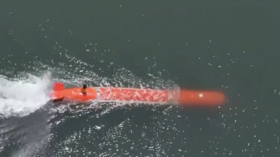Russia will be world’s leading ‘blue’ hydrogen exporter by 2030 – Gazprom

Russia plans to substitute the potential decline in gas exports to Europe with ‘blue’ carbon-neutral hydrogen, as the country sets to become the globe’s leading exporter of the emission-free fuel by 2030, Gazprom says.
The production of ‘blue’ hydrogen is already possible with the cost estimated at around $2 per kilogram, according to Sergey Komlev, the department head of Gazprom Export, the trade arm of Russia’s top gas producer.
Also on rt.com Russia ramps up its hydrogen energy ambitions“This will enable Russia to be the world’s top exporter of ‘blue’ hydrogen in the future, which will have a positive influence on the reputation of the gas sector, stop the process of gas assets’ devaluation, and lead to responsible financing of projects in the field of decarbonized natural gas,” Komlev said in an interview with Gazprom’s in-house magazine.
The turn towards hydrogen follows the current European policy of carbon neutrality, and its target of reducing its carbon footprint to zero by 2050 under the EU Green Deal. The interim goal within this policy sets a 55% decrease in emissions by 2030.
Also on rt.com The hydrogen hype is real, but is it justified?“Reaching carbon neutrality means abandoning fuels that are sources of greenhouse gases [which] will inevitably affect the volumes of direct supplies of natural gas from Russia and, consequently, the amounts of export revenues from its sales,” Komnev said.
He believes Russia can maintain its export positions on the European market by switching to emissions-free ‘blue’ hydrogen produced from natural gas.
Russia has introduced its roadmap for hydrogen production in 2020. In April 2021, the government unveiled a plan to reach a 20% share in the global hydrogen market by 2030, and to gradually increase annual exports of the fuel up to 33.4 million tons worth $100.2 billion by 2050.
Also on rt.com The end of gas guzzlers? EU mulls banning all new cars powered by diesel & gasoline by 2035 – mediaThe country expects domestic demand to continue to rely heavily on oil and gas, meaning that nearly all of its hydrogen production will be aimed towards export. The fuel production is expected to start in 2023 using carbon capture and storage (CCS) technology on Russia’s existing natural gas sites.
Last year, the Russian government included hydrogen energy in its broad energy strategy, with agreements on cooperation in the sphere of hydrogen energy signed with Germany and Japan.
For more stories on economy & finance visit RT's business section















